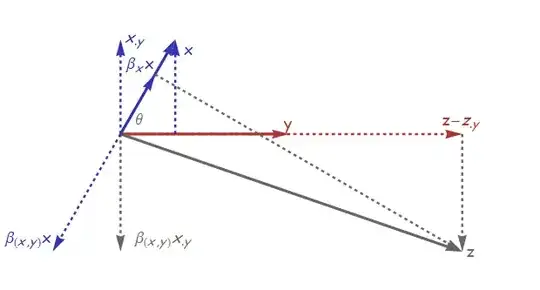I am trying to find an intuitive illustration -- particular of varimaxand quartimax -- to inform the choice of rotation (in the context of a principal components analysis).
I am aware of the formal definition of the two, and these two formidable answers on the topic.
In short, varimax maximizes the variance of loadings on each component (column-wise, so to speak), whereas quartimax minimizes the number of high-loading components on each variable (row-wise, so to speak).
In other words, varimax "explains" components with maximally varying variables, whereas quartimax "explains" variables with as few components as possible.
The way I understand rotation procedures, they are a way to make loadings matrices human-readable, much like concepts in general make the world human-readable. (For example, the concept "friendliness" is a way to make the manifold variations of human behaviours intelligible).
Now I suggest that varimax and quartimax (as well as other rotation procedures) can be understood as alternative logics (?) to formulate such concepts.
I'd like to find a good example to illustrate this rotation-as-concept-formulation.
My first attempt at such an illustrative example is this:
- let us take an example of Q-Mode PCA on foods, where dishes are variables (say, a BLT-sandwhich, a curry, ...), and food characteristics are cases (say, salt content, calories, etc.).
- let the points in the below loadings plot (not biplot!) be dishes (variables), as they are correlated with other dishes across various food characteristics (as cases).
- assume further that we're only retaining the first two components from a PCA over various dishes
- the red axes are the axes as "drawn" by
varimax, with variables often loading high on both components (many variable-points are in the corners of the plot) - the green axes are the axes as "drawn" by
quartimax, with variables often loading high on only one component (many variable-points are on/close to the axes of the plot).
I have tried to label (interpret) these fictitious axes in a meaningful way; maybe varimax components would be warm-cold, sweet-hearty/savory, whereas quartimax components would be lunch-dinner, domestic-foreign.
Under varimax-rotation, dishes would then be conceptualized in what might (preliminarily) be called clear-cut, abstract terms: any given dish will likely vary strongly along these dimensions (it's rare to have a dish that you're eating somewhat warm, and that is somewhere in-between sweet and savory).
On the other hand, it's not really clear what a savory dish would be, that is not also either hot or cold (there are few dishes on the axes).
Conversely, under quartimax-rotation, dishes would be conceptualized in a more mushy, but authentic way: any given dish may be somewhere along the domestic-foreign continuum (say, a pizza hawaii in Italy), but the extremes of the axes do make sense: there is, conceivable, such a thing as a foreign dish (say, sushi), that is neither lunch nor dinner.
The axes, are, in other words, occupied, including at the extremes.
Both conceptualizations of dishes, naturally, make sense, but in a different way: quartimax emphasizes categories that can actually be observed in pure form, whereas varimax emphasizes categories that are maximally distinct.
Now, my questions:
- Did I get
varimax,quartimaxapproximately right? Does this make sense? - Can you help me come up with a better example?
- In particular, can you help me come up with an example in R-mode PCA (not Q-mode)? (I'm used to Q, and couldn't help wrap my head around in R-mode, but that should make this more generally meaningful).
- Bonus: How would alternative rotation methods figure in this example:
equamaxandparsimax(let's stick to orthogonal procedures for now ...).
